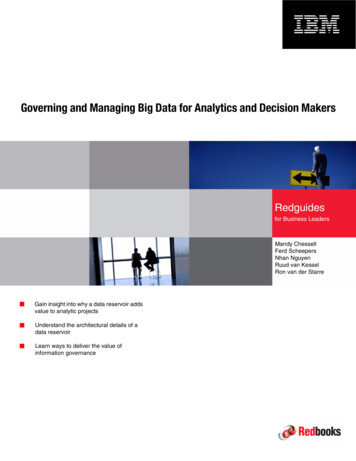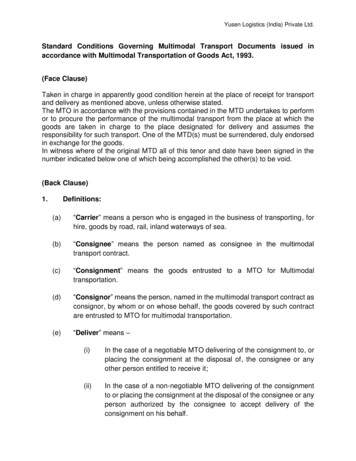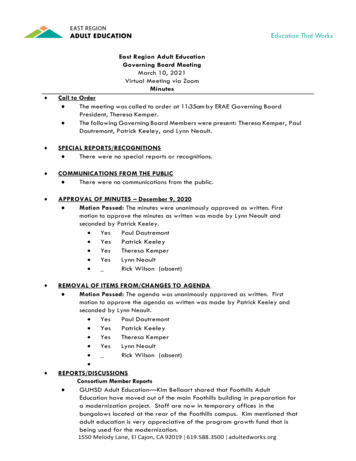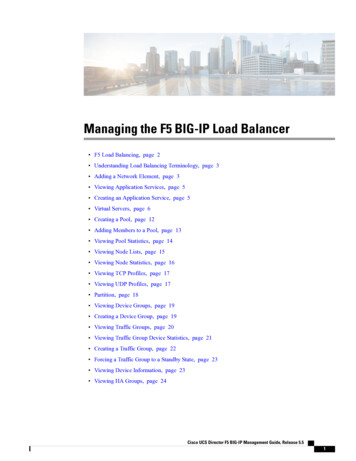
Transcription
Front coverGoverning and Managing Big Data for Analytics and Decision MakersRedguidesfor Business LeadersMandy ChessellFerd ScheepersNhan NguyenRuud van KesselRon van der StarreGain insight into why a data reservoir addsvalue to analytic projectsUnderstand the architectural details of adata reservoirLearn ways to deliver the value ofinformation governance
IntroductionIt is estimated that a staggering 70% of the time spent on analytics projects is concerned withidentifying, cleansing, and integrating data, because of the following issues: Data is often difficult to locate because it is scattered among many business applicationsand business systems. Frequently the data needs reengineering and reformatting in order to make it easier toanalyze. The data must be refreshed regularly to keep it up-to-date when it is in use by analytics.Acquiring data for analytics in an ad hoc manner creates a huge burden on the teams thatown the systems supplying data. Often the same type of data is repeatedly requested and theoriginal information owner finds it hard to keep track of who has copies of which data.As a result, many organizations are considering implementing a data lake solution. A datalake is a set of one or more data repositories that have been created to support datadiscovery, analytics, ad hoc investigations, and reporting. The data lake contains data frommany different sources. People in the organization are free to add data to the data lake andaccess any updates as necessary.However, without proper management and governance, such a data lake can quickly becomea data swamp. A data swamp is overwhelming and unsafe to use because no-one is surewhere data came from, how reliable it is, and how it should be protected. IBM proposes anenhanced data lake solution that is built with management, affordability, and governance at itscore. This solution is known as a data reservoir. A data reservoir provides the rightinformation to people so they can perform the following activities: Investigate and understand a particular situation or type of activity. Build analytical models of the activity. Assess the success of an analytic solution in production in order to improve it.A data reservoir has capabilities that ensure the data is properly cataloged and protected sosubject matter experts have access to the data they need for their work. This design point iscritical because subject matter experts play a crucial role in ensuring that analytics providesworthwhile and valuable insights at appropriate points in the organization’s operation. With adata reservoir, line-of-business teams can take advantage of the data in the data reservoir tomake decisions with confidence. Copyright IBM Corp. 2014. All rights reserved.1
This IBM Redguide publication discusses the value of a data reservoir, discusses how it fitsinto the existing business IT environment, and identifies sources of data for the data reservoir.It also provides a high-level architecture of a data reservoir and discusses key components ofthat architecture. It identifies key roles essential to creating, supporting, and maintaining thedata reservoir and how information integration and governance play a pivotal role insupporting the data reservoir.A view from INGBefore diving into the details of the data reservoir, it is worth pausing to consider the businessvalue of the data reservoir solution. This solution was the result of a partnership between INGand IBM.Ferd Scheepers of ING stated “Having both the perspective of a large international bank andone of the biggest IT vendors in the world, and challenging each other at every turn really wasa great example of what a partnership can be. The data reservoir architecture was developedto work independent of technology choices. But having IBM at the table helped in making surethat it didn't become a great architecture on paper only, but an architecture that can berealized by technology that is available today, whilst being open enough to embrace newtechnologies in the future.”ING is a large international bank. Banks have much data about their customers. This dataincludes how much a person earns, what they spend their money on, where they live, evenwhere they travel or eat. Similar types of information may be shared on a social media site.However, people who willingly share their information on a social media site know that thisdata will become more or less public. When people share their data with their bank, they trustthat the bank will use this data responsibly, for the purposes that the data was shared, andthis responsibility goes further than of just abiding by the law.Take a customer’s payment transactions as an example. Many customers would be unhappyif they felt the bank was monitoring how they spent their money. However, they would probablyalso expect the bank to detect fraudulent use of their debit card.Both of these use cases involve the same data but the first example seems to be prying into aperson's privacy and the second is an aspect of fraud prevention. The difference between thecases is in the purpose of the analytics. So as the bank makes data more widely available toits employees for the purpose of analytics, it must monitor both the access to data and thetypes of analytics it is being used for.Bringing data together in a data reservoir makes it easier to enforce standards, but having allthe data in one place creates a much higher risk of loss or misuse of information if thesecurity of the system is compromised. The data reservoir addresses this dilemma with itsinformation governance and security capabilities.No data can enter the data reservoir without first being described in the data reservoir’scatalog. The data owner classifies their information sources that will feed the data reservoir todetermine how the data reservoir should manage the data, including access control, qualitycontrol, masking of sensitive data, and data retention periods.The classification assigned to data created different management actions in the datareservoir. For example, when data is classified as highly sensitive, the data reservoir canenforce masking of the data on ingestion into the data reservoir. Less sensitive data, that isnevertheless personal to the bank’s customers, may be stored in secured repositories in thedata reservoir, so it can be used for production analytics. However, when it is copied intosandboxes for analytical discovery, it will be masked to prevent data scientists from seeing the2Governing and Managing Big Data for Analytics and Decision Makers
values, without loosing the referential integrity of the data. Behind the scenes, the datareservoir is auditing access to data to detect if employees are accessing more data than isreasonable for their role. Thus the data reservoir is opening access to the bank’s data, butonly for legitimate and approved purposes.A second challenge banks face is adopting real-time processing. In the past, banking wasmostly batch-oriented. Payments were processed over a few days and banking was done inoffice hours. Nowadays people buy online 24 hours a day, every day of the week, from manycountries around the world, and they expect their bank to support this. People interact withbanks more and more on their mobile devices, creating more contact moments, but they aremuch shorter. This situation has a huge impact on how the bank operates which impacts thesupporting IT systems.In a real-time environment, the actuality of data becomes the most important factor. The bankmust focus on real-time processing, both for fraud detection and also for customer service.Offering a loan in real time requires real-time analytics work with the most up-to-date riskprofile for the requesting customer. Banking customers also expect real-time insights intotheir spending patterns, including the transaction they just did a few seconds before. So datamust be continuously consolidated and reconciled for real-time processing, while alsosupporting the traditional, batch-oriented processes such as financial reporting that relies ondaily reconciled results. The architecture is open in supporting a combination of real-time andbatch ingestion. Even in a real-time world, some processes will stay batch-oriented for yearsto come.A third challenge that most companies face is making data accessible to the business usersin the organization. Data for business users must be formatted to support simple visualizationtools, labeled with relevant business terminology and in step with the data in the systems orrecord. At the same time, broad access to all types of raw data is needed by data scientists todevelop advanced analytics algorithms. The open architecture supports different formats ofdata for different types of users, based on the same data values.The close cooperation between ING and IBM is a win-win. For IBM, it is an opportunity toexplore improvements to their product portfolio and for ING, we believe the partnership willsupport our journey to becoming a real-time predictive bank, offering great service and trustto our customers.What is a data reservoirOrganizations that want to improve their decision making with analytics face variouschallenges: Getting enough data points to understand key situations and building the analyticalgorithms that capture the appropriate decision logic. Deploying analytical algorithms so they can perform the following activities:– Detect appropriate and related situations.– Retrieve the stored information needed to understand the broader context.– Use historical experience to predict what could happen. Ensuring the insights from the analytics is acted upon by the organization in a timelymanner. Collecting evidence on the effectiveness of the analytical decisions to enable a process ofcontinuous improvement.3
Success requires a triad of trusted information, a suite of analytical algorithms and tools,along with human engagement. The data reservoir provides the following capabilities: Flexibility in supplying data to analysts, data scientists, and business teams.Efficiency in extracting and maintaining data.Dependability in the protection and governance of data.Choice in the analytics deployment environment for performance and impact.The high-level structure of the data reservoir is shown in Figure 1.2Data Reservoir Services13Data Reservoir RepositoriesInformation Management and Governance FabricData ReservoirFigure 1 Data reservoir overviewThere are three main parts to a data reservoir described as follows: The data reservoir repositories (Figure 1, item 1) provide platforms both for storing dataand running analytics as close to the data as possible. The data reservoir services (Figure 1, item 2) provide the ability to locate, access,prepare, transform, process, and move data in and out of the data reservoir repositories. The information management and governance fabric (Figure 1 item 3) provides theengines and libraries to govern and manage the data in the data reservoir. This set ofcapabilities includes validating and enhancing the quality of the data, protecting the datafrom misuse, and ensuring it is refreshed, retained, and eventually removed at appropriatepoints in its lifecycle.The data reservoir is designed to offer simple and flexible access to data because people arekey to making analytics successful.Analytics in the business worldIn order to understand how data and people are key to analytics, let us step back and look ata real world situation and understand how a subject matter expert makes a decision.Consider an experienced sales assistant working with a customer buying a gift for a friend.The sales assistant recognizes the customer and remembers that this person typically buysexpensive gifts and frequently at the last minute. The sales assistant understands that the giftmust be immediately available.4Governing and Managing Big Data for Analytics and Decision Makers
The sales assistant asks about the friend's preferences and the type of gift the customerwants. Using their experience, the sales assistant suggests some products that sell well inthese circumstances.In this example, the sales assistant is making a decision on what to offer this customer. Whenpeople make decisions it is rare that all of the information they need is readily available.Effective sales assistants combine key information, such as: Details about the current situation (this is a repeat customer wanting to buy a gift that isavailable immediately) Knowledge of the broader context (the customer’s previous buying habits) Experience in similar situations with successful outcomes (knowledge of products popularwith similar people within the same price bracket)Throughout the process, the assistant is continually testing the results of their suggestions inorder to tune their understanding and improve their decisions. This additional understandingnot only improves this particular decision, but impacts future decisions as well.Many analytic algorithms work in a similar way to the human decision making process. Thesealgorithms draw information from the present situation and combine it with stored knowledgebases in order to determine a recommendation or classify a situation. It is important tounderstand, however, that analytics are not as adaptive to subtle changes and differences ineach new situation as humans are.Even the most sophisticated analytics available today is not as good as a human subjectmatter expert at creating new knowledge and improving the decision-making process. Humanexpertise is almost always a part of the process of creating new analytics, improving existinganalytics, and making ad hoc decisions. Experts must teach the analytic tools how to makedecisions in the same way that the experienced sales assistant trains a new assistant.However, once the analytic algorithm is configured properly, the expertise it represents can beused over and over again.Working with a data reservoirThe objective of the data reservoir is to give people access to the data they need to operateaspects of the business and build analytic solutions. Another objective is to ensure that muchof the creation and maintenance of the data reservoir is accomplished with little to noassistance and additional effort from the IT teams.Figure 2 on page 6 shows the overall usage flow for a data reservoir.5
45Discover6ExploreAccess21AdvertiseCatalog3Data Reservoir RepositoriesProvisionFigure 2 How does the data reservoir operate?The activities identified in Figure 2 are described as follows: Advertise (Figure 2, item 1)Whenever there is a new source of data to add to the data reservoir, it is advertised in thedata reservoir’s catalog. Catalog (Figure 2, item 2)The catalog described the data in the data reservoir and how it will be managed andgoverned. It enables people to locate and manage the data they need. This catalog isorganized so that data can be classified in various ways making it easy for different teamsto find what they need. Provision (Figure 2, item 3)Provisioning is when the data is incorporated into the data reservoir. Typically all futurechanges made to the original source of data are synchronized with the copies in the datareservoir. This approach provides for a regular flow of data into the data reservoir. Discover (Figure 2, item 4)The catalog is used to discover where data of a particular type is located. Explore (Figure 2, item 5)Once located, the data values can be explored to verify that this is the right type of data. Access (Figure 2, item 6)Data can then be accessed directly or copied into a sandbox for use by an analysis tool.With this basic set of capabilities identified, the key activities that can be performed on a datareservoir are covered in more detail in the following sections.Discovering dataAn information source documented in the catalog has many types of descriptive fields thatexplain where it came from, who owns it, last time the data was refreshed, and structural andprofile information. It also includes links to resources that use the information source in orderto make it possible to understand both the lineage of an information source and the impact ofany change to it. The catalog can be extended to include additional classifications, links, andresource types. By having all this information in the catalog, it creates a wealth of knowledge6Governing and Managing Big Data for Analytics and Decision Makers
about the content of the data reservoir. Examples of attributes that can be used to organizethe information in the data reservoir are shown in Table 1.Table 1 Example attributesAttributeDescriptionSubject areaThe subject area describes what topic the information is about. For example, it couldbe customer data, payment data, or product data. A subject area has an associatedglossary of terms that can be linked to the individual fields in an information sourceto pinpoint the exact meaning of the information values it contains.ZoneA zone provides a course-grained grouping of information sources for a particulartype of usage. An information source can be located in multiple zones.LocationLocation defines where the information source is located. Is it within this datareservoir, a related reservoir, or a particular external source that can be provisionedinto the data reservoir on request?Level ofconfidenceLevel of confidence indicates the known level of quality of the information andconsequently how much confidence to have in the information.From the catalog it is possible to select a small collection of related information and eitheraccess the data in its original location or have it copied into a sandbox for private use byanalytics and visualization tools.Creating simple reports and views of informationA catalog query shows the information sources that contain information of interest. Thesesources are copied into simple files for use by a spreadsheet or reporting tool assuming therequester has sufficient security access. The process of copying information into the simplefiles is initiated from a selection menu to choose which values you are interested in, howfrequently you want the information refreshed, and how much information you want returned.The files are managed by the data reservoir.Investigating unusual activityInvestigating unusual activity often requires a wide range of information sources. The catalogfor the data reservoir provides search capability to identify which sources of information arepotentially of interest to the investigation.Creating new analyticsData scientists can also use the catalog to locate useful data for building new analyticsroutines. Once the wanted data is located, it can easily be copied into a sandbox so the datascientist can start preparing and analyzing the data as part of the analytics definition process.Capturing new data and insightThe data reservoir is an interactive data environment with the ability for all types of users toadd new data. When someone wants to add a new source of data, they perform the followingsteps: Advertise that the data is available in the catalog Arrange for the data to be provisioned into one or more of the data reservoir’s repositories Enable others to find, explore, and access the data7
Validating the authenticity and protecting informationA key to information governance is the classification of data, data repositories, types ofprocessing, and the people consuming the data. These classifications are linked togovernance policies and rules that are applied to the data as it is processed in the datareservoir.The data reservoir’s catalog contains the definitions of the policies, rules, data classifications,data repositories, data types, and processing descriptions. It also includes links to compliancereports. It is possible to search for specific items and navigate between these definitions tounderstand how data is being protected and managed in the data reservoir.The catalog is also record
IBM proposes an enhanced data lake solution th at is built with management, affo rdability, and governance at its core. This solution is known as a data reservoir. A data reservoir provides the right .











